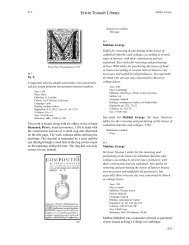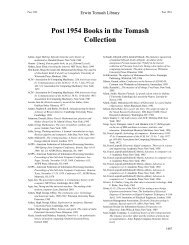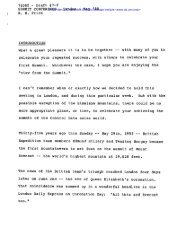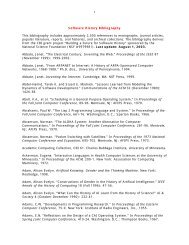B chapter.indd - Charles Babbage Institute - University of Minnesota
B chapter.indd - Charles Babbage Institute - University of Minnesota
B chapter.indd - Charles Babbage Institute - University of Minnesota
You also want an ePaper? Increase the reach of your titles
YUMPU automatically turns print PDFs into web optimized ePapers that Google loves.
Erwin Tomash Library<br />
Bernoulli, John III Beutel, Tobias<br />
While making contributions in many areas <strong>of</strong> mathematics<br />
and mechanics, this volume contains Jacob’s most<br />
famous work. It is considered as the foundation <strong>of</strong> the<br />
mathematical theory <strong>of</strong> probability and, indeed, has<br />
been termed the foundation <strong>of</strong> the field <strong>of</strong> mathematical<br />
statistics. The editing <strong>of</strong> the manuscript was incomplete<br />
when Jacob died and his nephew Nicolas (the son <strong>of</strong><br />
Jacob’s brother <strong>of</strong> the same name) saw it through the<br />
press. This work, whose title means casting, as in the<br />
casting <strong>of</strong> dice (not counters), is divided into four parts.<br />
The first is a discussion <strong>of</strong> Huygens’ De ratiociniis in<br />
alae ludo, and the second deals with permutations in<br />
which Bernoulli derives a number <strong>of</strong> fundamental notions<br />
about series. The third applies the theory developed in<br />
Part II to twenty-four examples <strong>of</strong> games <strong>of</strong> chance for<br />
which Bernoulli calculates the odds. The final section<br />
is more philosophical in nature and makes reference to<br />
moral as opposed to mathematical expectation and the<br />
law <strong>of</strong> large numbers (the fundamental underpinning <strong>of</strong><br />
most simulations). This last section also contains some<br />
comments on jeu de paume—a game similar to modern<br />
tennis having little to do with the major topic <strong>of</strong> the<br />
work. This is Jacob’s thinly disguised satirical response<br />
to some caustic criticisms made earlier <strong>of</strong> his views on<br />
scholarly logic.<br />
Illustrations available:<br />
Title page<br />
B 144<br />
Bernoulli, John III (1744–1807)<br />
A sexcentenary table; exhibiting at sight, the result <strong>of</strong><br />
any proportion, where the terms do not exceed 600<br />
seconds or 10 minutes with precepts and examples.<br />
b/w: Taylor, Michael S.; A sexagesimal table …, 1780<br />
Year: 1779<br />
Place: London<br />
Publisher: William Richardson<br />
Edition: 1st<br />
Language: English<br />
Binding: contemporary half-bound leather, marbled boards;<br />
rebacked; red leather label<br />
Pagination: pp. viii, 165, [1]<br />
Collation: a–b 2 A–2S 2 T 1<br />
Size: 284x229 mm<br />
See the entry for Taylor, Michael S.A.; A sexagesimal<br />
table…,1780.<br />
John (Johann) Bernoulli, a member <strong>of</strong> the famous Swiss<br />
mathematical family—the grandson <strong>of</strong> Johann and<br />
grandnephew <strong>of</strong> Jacob Bernoulli, was a child prodigy,<br />
obtaining a master <strong>of</strong> jurisprudence degree at age<br />
fourteen. By the age <strong>of</strong> twenty, he was asked by Frederick<br />
II to reorganize the observatory in Berlin. While his<br />
mathematical works are not <strong>of</strong> great importance today,<br />
he wrote many papers on diverse subjects and eventually<br />
became the trustee <strong>of</strong> the family documents.<br />
Illustrations available:<br />
Title page<br />
B 145<br />
Beutel, Tobias<br />
B 144<br />
Neu auffgelegte Arithmetica, Oder sehr nützliche<br />
und schöne Rechen-Kunst mit kurtzen Regulen und<br />
Exemplis, Nach der Practica, welche ausführlich<br />
hierinnen beschriben ist, nebenst der Coss oder<br />
Algebra.<br />
Year: 1670<br />
Place: Leipzig<br />
Publisher: Printed by Johann Wittigau for Philip Fuhrman<br />
Edition: 4th<br />
Language: German<br />
Figures: engraved frontispiece; title in red and black<br />
Binding: Contemporary vellum; with ties<br />
Pagination: pp. [24], 502, [2] (interleaved from p. 1 to p. 475)<br />
Collation: ):( 12 A–X 12<br />
Size: 127x75 mm<br />
Reference: Pogg Vol. I, p. 181<br />
This copy is interleaved with contemporary inscriptions<br />
in finely penned handwriting in brown ink.<br />
This arithmetic book begins with numeration (including<br />
an example <strong>of</strong> Roman numerals using some <strong>of</strong> the<br />
alternate forms for “M”) and continues with the four<br />
basic operations and rule <strong>of</strong> three, multiplication being<br />
illustrated with an unusual triangular table. The same<br />
material is repeated in the next section, this time dealing<br />
137







